Starting stage 1 baby foods
10 Baby Food Purees (Stage 1)
Everything you need to know about making stage 1 baby food, including 10 recipes for tasty purees that are perfect for introducing solids.
Introducing solids to your baby is such an exciting milestone but it can also be an overwhelming time with lots of questions. When is your baby ready for solids? Which foods should you start with? And how do you make homemade baby food?
I’m here to make sure you have all the information you need! Plus sharing 10 baby food purees to give you some ideas of where to start if you’ve decided to make your own baby food.
When To Start Solids
Most pediatricians recommend babies start solids between 4-6 months, but you know your baby best so trust your gut and do what feels right to you (with guidance from your pediatrician)!
I have a great guide for introducing solids to babies where I outline the basics and share my approach, but just to recap, here are some signs that your baby is ready to start enjoying solid food:
- Baby can hold their head up in an upright position without too much bobbing
- Baby can sit up with (or without) support
- Baby has lost the tongue thrust reflex
- Baby puts their hands or toys in their mouth
- Baby has shown interest in food such as leaning forward and opening their mouth or trying to grab food you’re eating
How to Introduce Solid Food to Baby
Once you’ve decided that your baby is ready to start solids, it’s go-time. There are different approaches to this including baby led weaning, where you skip purees all-together and let your baby feed themselves with finger foods from the start and traditional weaning, which starts with pureed (or blended) foods.
With Olivia I did a hybrid approach where the first few foods we introduced where purees and then we started with a few finger foods when she seemed ready. I go into more detail on this in my introducing solids post.
To be honest, if you’re planning to do baby led weaning this post probably won’t be that helpful because it’s focused on how to make a variety of single ingredient purees.
What is Stage 1 Baby Food?
If you decide to use purees, you’ll quickly notice that baby food is labeled by three stages. Here is a breakdown of what these different stages mean:
- Stage 1 (4-6 months) – single ingredient foods that are pureed into a very thin consistency with no chunkiness whatsoever that can be served with a spoon.

- Stage 2 (around 6-8 months) – slightly thicker consistency and typically includes food combinations and the addition of spices like cinnamon, nutmeg, turmeric, mint, basil, etc. See my stage 2 baby food combos.
- Stage 3 (around 9-12 months) – thick blended foods with chewable chunks or small cut up pieces of easily chewed food.
Best First Foods for Baby
Solid foods can be introduced in any order, but most pediatricians recommend starting with a single-ingredient food that is easy to digest like pureed sweet potato, carrot, banana and/or avocado. Other options include pureed meats, poultry, beans and iron-fortified baby cereals like rice cereal or oatmeal.
You just want to be sure the first few foods are pureed super smooth and almost a liquid consistency. You can easily thin purees with breastmilk or formula.
As baby gets more practice with eating you can reduce the amount of liquid and offer purees with a thicker texture.
Food Allergies and Known Allergens
When introducing foods it can be helpful to introduce only one food every three to five days so you can watch for any signs of allergic reactions. A reaction could show up almost immediately or a few days after so it’s recommend to introduce one food at a time when starting out so you can track what may be causing a reaction in your baby. Reactions include: hives or rashes, itching, shortness or breath or more serious reactions like vomiting or swelling of the lips and tongue.
It’s also helpful to be mindful about common allergens. Foods like diary, eggs, peanuts, tree nuts, wheat, soy and shellfish should be introduced gradually after less allergenic foods have been tolerated. The previous recommendation was to wait on these foods, but that as since changed and in fact, delaying the introduction of these foods may increase the risk of a child developing allergies.
One food that is off limits until a baby is at least 1 year old is honey because of the risk of infantile botulism.
How to Make Homemade Baby Food
We covered when and what foods to start with. Now lets talk how to make a basic baby food puree! Don’t fret, it’s super easy. Here’s the basic process:
- Prep: you’ll want to start by ensuring your fruit or vegetable of choice is thoroughly cleaned. Even if you’re using organic fruits and vegetables, you’ll want to washed and dry your produce! Once the produce is clean, you’re ready to peel and chop into chunks. You can skip this step for some fruits or veggies.
- Cook: some foods like banana and avocado don’t need to be cooked, but many do. For cooking, you can steam, boil or roast. I recommend using a fork to test that they’re tender and soft.
- Blend: place cooked food into a blender or food processor and blend until smooth (or the consistency you desire), adding liquid (breast milk, formula or water) as needed.
That’s it! You’ve just made a homemade baby food puree!
Best Tools For Making Homemade Baby Food
You really don’t need any fancy kitchen appliances, but there are a few tools that will come in handy when making homemade baby food.
- Steamer basket – Steaming is one the easiest ways to cook foods for making purees and having a steamer basket is key. I have a really basic steamer basket that fits in most pots, but I also use the steamer basket that comes with my Always Pan.
- Blender – I’ve been using my Vitamix blender and love how smooth it makes the purees. You can also use a food processor or an immersion blender.
- Silicone ice cube trays – In the beginning I really liked to make large batches of pureed food and pour it into a silicone ice cube tray with a lid to freeze for later. It was perfect when babies aren’t eating big portions because each cube is about 1-2 ounces.
- Freezer bags – Once you have frozen cubes of puree you can transfer them to a freezer-safe bag. I love reusable Stasher bags for this.
- Storage containers – As soon as you start making homemade baby food you realize that you need lots of little containers.
 A friend loaned me a bunch of plastic storage containers for keeping homemade baby food and I also invested in these glass containers that are freezer safe.
A friend loaned me a bunch of plastic storage containers for keeping homemade baby food and I also invested in these glass containers that are freezer safe. - Permanent markers – When storing and freezing baby food you’ll want to label everything with the name of the food and the date.
- Baby food maker – if you’re looking for an all-in-one solution that steams food and blends it there are some cool gadgets (like the BEABA Babycook) that make homemade baby food a breeze!
10 Stage One Baby Food Purees
Ready to get started making some stage 1 baby food purees? Here are 10 easy recipes to get you started. These are the purees I used in the early days with Olivia. She loved all of these, but there are a ton of other purees you can try including pear puree, apple puree (aka applesauce), bean purees (like chickpea or lentil puree) and even chicken puree.
Sweet Potato
Sweet potatoes are a powerhouse vegetable! They’re packed with fiber, vitamins, minerals and antioxidants and babies love their sweet flavor.
Sweet Potato Puree
3.88 from 8 votes
Sweet potato puree is so easy to make. Just bake your sweet potatoes, peel and blend until smooth! It's a great first food for babies, but can also be used in baking recipes, mixed into oatmeal, added to smoothies or served as a side dish.
Get Recipe
Carrot
Carrots are low on the allergy scale and easily digested by a tiny tummy. They are high in beta-carotene, an antioxidant that converts to vitamin A in the body, which is crucial for eye health and overall immune function.
Carrot Puree
4 from 39 votes
How to make carrot baby food by cooking and blending carrots into a smooth and creamy puree. Carrot puree make a great stage 1 starter food for babies.
Get Recipe
Avocado
Avocados are high in heart-healthy fats as well as fiber, vitamins, minerals and antioxidants! They’re incredibly nutritious and super easy to prepare.
Avocado Puree
5 from 3 votes
Avocado is great first food for babies. It contains healthy fats, it’s easy to blend and it’s delicious. Make it in your food processor or blender or simply mash!
Get Recipe
Banana
A great first food to introduce to babies, bananas are naturally soft and mushy, easy to digest and loaded with vitamins and minerals. The best part? You don’t need to cook them!
Banana Puree
5 from 2 votes
Fresh banana puree is a great first food and baby will love it because it tastes sweet! Easily make it by mashing or blending ripe bananas.
Get Recipe
Peas
Peas are naturally sweet and pack a punch with nutrition, containing a variety of vitamins, minerals and antioxidants. They are also high in protein, with 4 grams per half-cup serving. Fun fact, peas are actually a legume!
Pea Puree
5 from 5 votes
Pea puree is a great first food when introducing solids to babies and all you need is a bag of frozen peas and a blender or food processor!
Get Recipe
Butternut Squash
Technically a fruit, butternut squash is packed with fiber, vitamins and minerals.
Butternut Squash Puree
Make butternut squash puree at home with this simple recipe! Just scoop the seeds, roast, blend and use in recipes that call for butternut squash puree. It's also a great first food for babies!
Get Recipe
Peach
Peaches are naturally sweet and perfect for introducing baby to solid foods. They are rich in many vitamins, minerals and antioxidants.
Peach Puree
5 from 4 votes
Peach puree is so easy to make using fresh peaches! It's a great first food for babies, but can also be used as a topping or mix-in for breakfast, dessert and drink recipes.
Get Recipe
Mango
Rich in vitamins, minerals and antioxidants, mango is especially high in vitamins A and C. They also contain a group of digestive enzymes called amylases which help little tummies just starting with solid foods.
Mango Puree
5 from 3 votes
How to make a delicious mango puree out of fresh (or frozen) mango. It's perfect for serving to baby or to use in recipes.
It's perfect for serving to baby or to use in recipes.
Get Recipe
Blueberry
Small but mighty! Blueberries are known as a superfood. Superfoods are usually plant-based and rich in nutrients that are beneficial to your health such as vitamins, minerals, healthy fats and fiber.
Blueberry Puree
5 from 1 vote
Blueberry puree is full of antioxidants and vitamins and makes for a quick and easy first food for baby! It can also be used as a topping or mix-in for breakfast, dessert and drink recipes.
Get Recipe
Strawberry
Strawberries pack quite a health punch! They are low calorie, taste delicious and are a great source of vitamins, minerals and plant compounds.
Strawberry Puree
5 from 1 vote
Strawberry puree is easy to make and naturally sweet with no added sugar! Use it in baked goods, drinks or as baby food.
Get Recipe
How to Store Purees
Freshly pureed baby food should be stored in the fridge and used within 3-4 days. For longer storage, I recommend freezing purees in an airtight container. I like using silicone ice cube tray or freezer safe jars because they make it easier to thaw smaller amounts for serving to babies.
For longer storage, I recommend freezing purees in an airtight container. I like using silicone ice cube tray or freezer safe jars because they make it easier to thaw smaller amounts for serving to babies.
How to Thaw Frozen Puree
I recommend thawing frozen purees in the fridge the night before you want to use them. In a pinch, you can also thaw it quickly with a warm water bath. It thaws quickly if you’re defrosting a small amount to serve to a baby.
FAQ
Can I store homemade baby food purees?
Yes! Making large batches of purees and storing them in the refrigerator or freezer makes feeding baby homemade purees a breeze.
Can you freeze homemade purees?
Freezing baby food that has been made with frozen fruit or vegetables is fine, as long as you have cooked the frozen foods first. Do not refreeze foods that have thawed without cooking. I recommend labeling baby food with the ingredient and date before you place them in the freezer.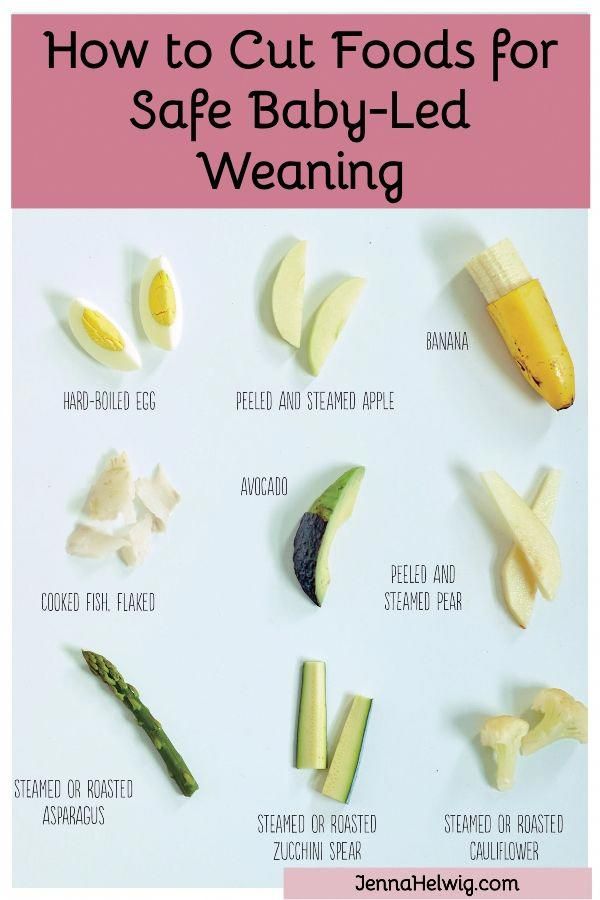
Can you freeze baby food made with breast milk or formula?
If you are freezing baby food that has been mixed with fresh breast milk you’re fine! However, you should not freeze baby food that has been mixed with previously frozen breast milk. Once frozen breast milk has been thawed, it should never be re-frozen.
If you are using formula, it should be okay to freeze baby food that has been mixed with it. Most formula companies don’t recommend freezing formula, but you’re using such a small amount.
You can also freeze the baby food purees without adding any liquid. You can then thaw the baby food puree in the fridge overnight and then thin the food to the desired consistency with breast milk or formula right before serving.
This post about freezing baby food has a ton of great insight and tips.
Should I use organic fruits and vegetables?
I recommend using organic produce when possible, though I realize this isn’t always in the budget. Either way thoroughly rinsing your fruits and vegetables is an important step whether they’re organic or not.
Either way thoroughly rinsing your fruits and vegetables is an important step whether they’re organic or not.
This list of the dirty dozen fruits and vegetables from the EWG is a good guide if you can only budget for some but not all organic produce.
Is it safe to thin baby food with cow’s milk?
From a nutritional point of view, most doctors recommend waiting to introduce babies to cow’s milk until one year of age. If you need to thin your puree you can use breast milk, formula or plain water.
What is the difference between stage 1 and stage 2 baby food?
Stage 1 purees are very thin with no chunkiness and are single ingredients. Stage 2 baby foods can be more elaborate with food combinations as well as chunkier textures.
More Recipes for Resources
- Baby Pancakes
- How to Make Oatmeal For Babies
- Baby (+ Toddler) French Toast
- Applesauce
- Baby Yogurt Melts
- 6 Baby Food Combinations (Stage 2)
Be sure to check out all of the baby food recipes here on EBF.
10 Stage One Baby Food Purees
5 from 5 votes
Everything you need to know about making stage 1 baby food, including 10 recipes for tasty purees that are perfect for introducing solids.
Print Recipe Pin Recipe
Prep Time 10 minutes
Cook Time 20 minutes
Total Time 30 minutes
Servings 6
Sweet Potato
- 2 cups steamed and peeled sweet potatoes
- water, breast milk or formula to thin
Carrot
- 1 lb steamed and peeled carrots
- water, breast milk or formula to thin
Avocado
- 1 avocado
- water, breast milk or formula to thin
Banana
- 1 banana
- water, breast milk or formula to thin
Pea
- 2 cups cooked peas
- water, breast milk or formula to thin
Butternut Squash
- 2 cups steamed and peeled butternut squash
- water, breast milk or formula to thin
Peach
- 3 ripe peaches
- water, breast milk or formula to thin
Mango
- 2 ripe mangoes
- water, breast milk or formula to thin
Blueberry
- 2 cups blueberries
- ½ cup water
Strawberry
- 2 cups strawberries
- water, breast milk or formula to thin
Add veggies or fruit into a high powered blender or a food processor.
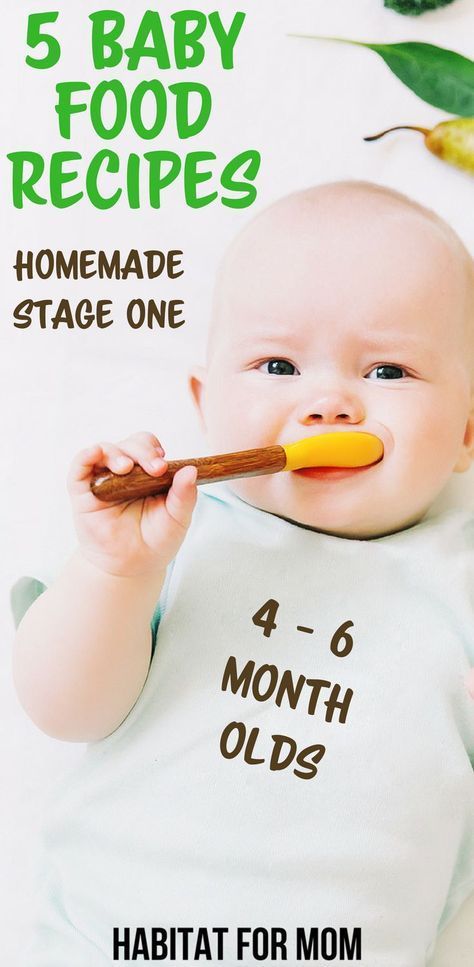 Blend and add liquid until you reach the consistency you desire. You can make the purees smooth and thin for young babies or thicker and chunkier for older babies.
Blend and add liquid until you reach the consistency you desire. You can make the purees smooth and thin for young babies or thicker and chunkier for older babies.
blender
food processor
Serving: 1sweet potato Calories: 75kcal Carbohydrates: 17g Protein: 1g Sodium: 48mg Potassium: 292mg Fiber: 3g Sugar: 4g
DID YOU MAKE THIS RECIPE?
Please leave a comment and star rating on this post and share on social media using the hashtag #eatingbirdfood. I love seeing your recipe shares!6 Baby Food Combinations (Stage 2)
6 easy and tasty baby food combination recipes: Sweet Potato Apple, Asparagus Apple, Blueberry Banana Quinoa Flax, Peach Pear, Avocado Peach Pineapple Kale and Pineapple Mango.
Earlier this week I shared a recipe for carrot baby food, which is a great first food for babies. Today I’m sharing 6 baby food combinations that work for babies who are a little older, around 6-8 months. The combos I’m sharing are mostly fruit and vegetables, but there is one combo with quinoa and flaxseed as well. All of these combos have been taste-tested and approved by Olivia. She gobbled up each of them!
The combos I’m sharing are mostly fruit and vegetables, but there is one combo with quinoa and flaxseed as well. All of these combos have been taste-tested and approved by Olivia. She gobbled up each of them!
Baby not ready for stage 2? I’ve got a collection of 10 baby food purees for stage 1 eaters!
The recipes I’m sharing here are just to give you some ideas of how to make different baby food combos, but there are so many other combos you can make – the options are endless and it’s fun to get creative!
Just last week I made a new combo inspired by carrot cake with steamed carrots, pineapple, ginger, nutmeg and cinnamon. I’ve also been making Olivia peanut butter banana oatmeal (with quick oats) and chia pudding made with breast milk. She loves both!
I haven’t introduced Olivia to meat, but we’ve given her eggs and I’m hoping to have her try meat soon. I’ll likely start with salmon since it’s packed with so many nutrients. Fingers crossed she likes it!
How to Make a Fruit or Veggie Puree
Alight, so let’s cover the basics first… how to make a basic baby food puree with fruit or veggies. It’s actually really easy. That said, if you’re brand new to making baby food purees it might be helpful to review my homemade carrot puree or sweet potato puree recipe. Here’s the basic process:
It’s actually really easy. That said, if you’re brand new to making baby food purees it might be helpful to review my homemade carrot puree or sweet potato puree recipe. Here’s the basic process:
- Prep: wash the fruit/veggies with water. Peel and chop into smaller pieces. Some fruits and veggies don’t need to be peeled because once they’re cooked the peel will come right off.
- Cook: cook the fruit/veggies by steaming, boiling or roasting. You’ll know it’s done when the veggies are soft and tender. I like to use a fork to test this. If it goes in really easily, I know it’s done. Let cool and peel (if you waited to peel).
- Blend: place cooked fruit/veggies into a blender or food processor and blend until smooth (or the consistency you desire), adding liquid (water, breast milk or formula) as needed.
Do You Need to Steam Fruits and Veggies for Baby?
It’s recommended that most fruits and veggies are steamed (or cooked) before serving until baby reaches around 8 months of age. Some foods require cooking (like apples and sweet potatoes), just so they’re soft enough to puree. For softer foods (like a ripe peach or blueberries) steaming/cooking is optional, but helpful for babies 6-8 months of age because cooking makes the food easier to digest and baby will able to absorb more nutrients from the food. As you’ll see in my recipes below, I like to use a steamer basket to steam most of my fruit and veggies before pureeing.
Some foods require cooking (like apples and sweet potatoes), just so they’re soft enough to puree. For softer foods (like a ripe peach or blueberries) steaming/cooking is optional, but helpful for babies 6-8 months of age because cooking makes the food easier to digest and baby will able to absorb more nutrients from the food. As you’ll see in my recipes below, I like to use a steamer basket to steam most of my fruit and veggies before pureeing.
Bananas and Avocado
Bananas and avocado are the exception and they are great options to have on hand because you can easily just mash, thin with liquid (if needed) and serve.
How to Make Baby Food Combinations
For all of these combination recipes, I steamed each fruit/veggie separately and then made the combos using the measurements I share in the recipes. I did it this way because I was batching all of these combos at once and I’m only able to fit so much in one pot, but also because the steam time varies for most fruits and veggies (see below). Of course, you will find some recipes (on other sites) that involve cooking the items that are combined all together, but I found it easier just to steam all of my ingredients separately, measure and then blend them together. Do what feels easiest for you!
Of course, you will find some recipes (on other sites) that involve cooking the items that are combined all together, but I found it easier just to steam all of my ingredients separately, measure and then blend them together. Do what feels easiest for you!
How to Blend Baby Food
Once your fruit/veggies are cooked, it’s time to blend. For this you can use a blender, food processor or even an immersion blender. I’ve been using my Vitamix and LOVE it for making baby food because it’s really powerful and makes the blends so smooth and creamy. Some foods don’t need to be blended for babies who are okay with a more chunky texture. You can simply mash them well with a fork.
Peeling the Fruit and Veggies
I highly recommend peeling your fruits and veggies because peeling results in smoother purees and makes the food easier for baby to digest. Some foods, like carrots, should be peeled before cooking, but other foods like sweet potato, apples, peaches and pears tend to have skin that peels right off after steaming. Ultimately it’s up to you whether you want to peel the fruit/veggies before or after steaming. Test it both ways and decide which option is easier for you. I’m team peel after steaming!
Ultimately it’s up to you whether you want to peel the fruit/veggies before or after steaming. Test it both ways and decide which option is easier for you. I’m team peel after steaming!
- 1 avocado
- 1 bunch of kale
- 1 sweet potato
- 1 bunch asparagus
- 1 banana
- 2 apples
- 2 pears
- 4 peaches
- 1 pint blueberries
- 1 pineapple
- 1 mango
- quinoa
- ground flax
Steaming Time For the Fruits and Veggies
As I mentioned above, it’s recommended that most fruits and veggies (even soft ones) are steamed (or cooked) before serving babies who are 6-8 months. If your baby is older you can experiment with using fresh blueberries, peaches, pears, pineapple and mango that hasn’t been steamed, so long as the fruit is ripe and soft. I actually used fresh blueberries when making the blueberry banana quinoa flax combo.
- Sweet potato: 12-15 minutes
- Apple: 10-12 minutes
- Asparagus: 7-13 minutes
- Blueberries: 5-10 minutes
- Peach: 2-4 minutes
- Pear: 10-12 minutes
- Pineapple: 5-10 minutes
- Mango: 5-10 minutes
Frozen fruit and veggies also work for these recipes.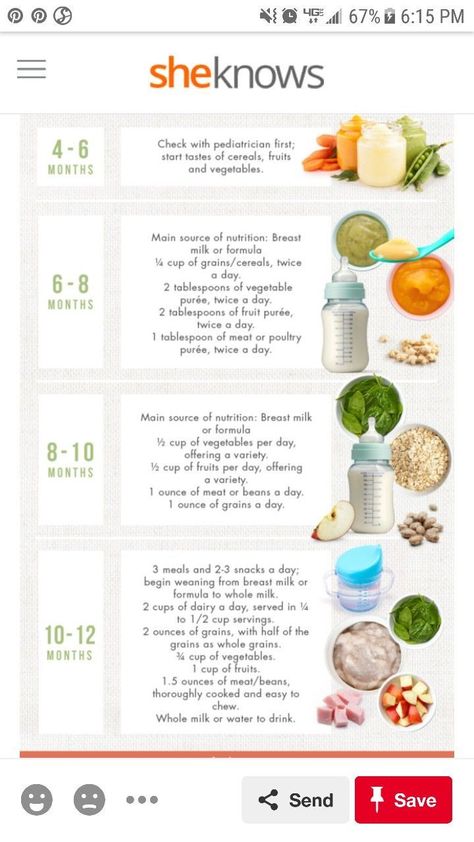 You’ll likely just need to steam them a bit longer.
You’ll likely just need to steam them a bit longer.
6 Easy Baby Food Combinations
Here are six different baby food combinations. I’ve listed them in order of the level of complexity from the least complex (peach pear) to most complex (blueberry banana quinoa and flax).
Peach PearIngredients: 2 steamed and peeled pears and 3 steamed and peeled peaches + water or breast milk to thin (if needed)
Asparagus AppleIngredients: 1 bunch of steamed asparagus, 1 steamed and peeled apple + water or breast milk to thin
Sweet Potato Apple CinnamonIngredients: 1 steamed and peeled sweet potato, 1 steamed and peeled apple, pinch of cinnamon + water or breast milk to thin
Avocado Peach Pineapple KaleIngredients: 1 avocado, 1 steamed and peeled peach, 1/2 cup steamed pineapple and 1/2 cup of steamed kale + water or breast milk to thin (if needed)
Pineapple MangoIngredients: 1 cup steamed pineapple + 1 cup steamed mango + water or breast milk to thin (if needed)
Blueberry Banana Quinoa Flax
Ingredients: 1 pint steamed blueberries, 1/2 cup cooked quinoa, 1 ripe banana, 2 Tablespoons of ground flaxseed + water or breast milk to thin (if needed)
How to Store Homemade Baby Food
Once you have the baby food blended to the consistency you want, let the mixture cool and then transfer into BPA-free storage containers or into an ice cube tray.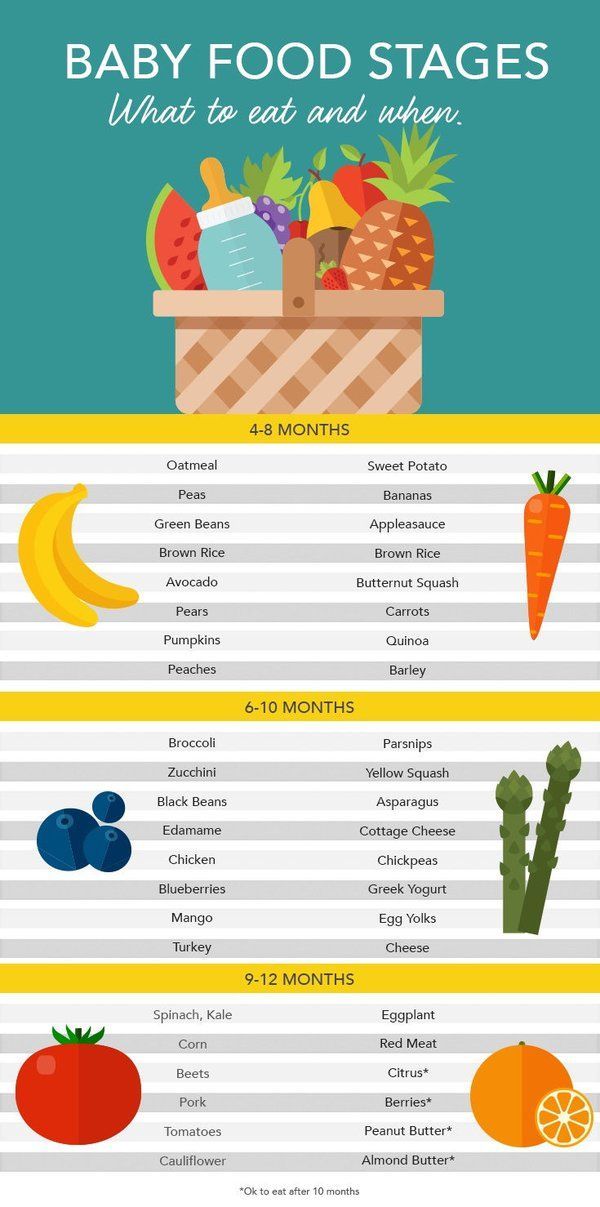 I’ve been using silicone ice cube trays and these 4 oz glass storage containers. The ice cube trays are great for younger babies who aren’t eating as much volume because you can defrost one cube at a time. While the 4 oz jars are great for older babies who are eating more than 1 oz at a time.
I’ve been using silicone ice cube trays and these 4 oz glass storage containers. The ice cube trays are great for younger babies who aren’t eating as much volume because you can defrost one cube at a time. While the 4 oz jars are great for older babies who are eating more than 1 oz at a time.
We had the ice cube trays on hand, and I just recently bought the WeeSprout glass storage containers that are specifically for baby food. I like that they have measurements on the side of the jars and that they’re glass instead of plastic (no worry about BPA). They are also freezer, dish-washer and microwave-safe. Plus they come with colorful lids that you can write on with a dry eraser marker to note the item and date.
When using the ice cube trays, I like to let the food freeze overnight (or until solid) and then transfer the cubes to a freezer bag so I can free up the ice cube tray for more food prep. I used plastic freezer bags for these photos but have since purchased reusable Stasher bags to use. They’re freezer safe and non-toxic and a healthier option for the environment.
They’re freezer safe and non-toxic and a healthier option for the environment.
The baby food combos will keep in the fridge for 2-3 days and in the freezer for up to 3 months.
Can You Freeze Baby Food Made with Frozen Fruit or Veggies?
Yes, you can freeze baby food that has been made with frozen fruit or veggies as long as you have cooked the frozen foods first. You shouldn’t let frozen foods thaw (without cooking), puree and re-freeze.
Can You Freeze Baby Food Made with Breast Milk or Formula?
Freezing baby food that has been mixed with fresh breast milk is totally fine, however you should not freeze baby food that has been mixed with previously frozen breast milk. Frozen and thawed breast milk should never be re-frozen.
Most formula companies don’t recommend freezing formula, but from what I’ve read it’s okay to freeze homemade baby food that has been mixed with formula to thin.
Another option is to freeze the baby food purees without adding any liquid.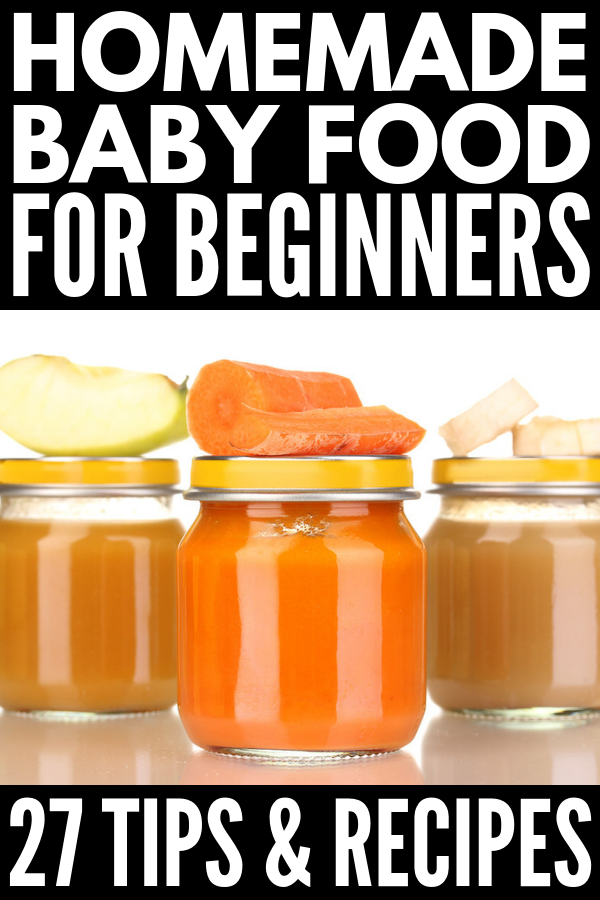 With this method you can thaw the baby food puree in the fridge overnight and then thin the food to the desired texture with breast milk or formula right before serving.
With this method you can thaw the baby food puree in the fridge overnight and then thin the food to the desired texture with breast milk or formula right before serving.
This post all about freezing baby food has a ton of great insight and tips.
Don’t Forget to Label
I highly recommend labeling any baby food you make before storing it! It’s amazing how quickly you forget what day you prepped the food once it goes into the fridge or freezer. #mombrain
How to Reheat or Thaw Frozen Baby Food
To thaw frozen baby food, I recommend taking the jar out of the freezer the night before you want to use it so it can defrost in the fridge overnight. If you need to use it right away, you can thaw it using a water bath. Some people will recommend microwaving the frozen puree using the defrost setting, but I prefer these two methods:
- Defrost in the refrigerator: Place frozen puree cubes into a jar or baby’s serving dish, cover, and place in the refrigerator overnight.
 If you stored the puree in a jar or storage container, simply place the jar the fridge.
If you stored the puree in a jar or storage container, simply place the jar the fridge. - Water bath: Place frozen pureed cubes in a small container and set in another larger container with warm water. Replace the water as needed. Once defrosted, portion the food into individual bowls, cover, and refrigerate until serving.
Be sure to use any of the defrosted food within 48 hours of being defrosted and do not re-freeze.
More Recipes for Babies and Toddlers
- 10 Baby Food Purees (Stage 1)
- Baby Pancakes
- How to Make Oatmeal For Babies
- Carrot Baby Food
- Peach Baby Food
- Baby (+ Toddler) French Toast
- Applesauce
- Baby Yogurt Melts
- Butternut Squash Puree
- Sweet Potato Puree
6 Baby Food Combinations
4 from 93 votes
6 easy and tasty baby food combo recipes: Sweet Potato Apple, Asparagus Apple, Blueberry Banana Quinoa Flax, Peach Pear, Avocado Peach Pineapple Kale and Pineapple Mango.
Print Recipe Pin Recipe
Prep Time 10 minutes
Cook Time 20 minutes
Total Time 30 minutes
Servings 6
Peach Pear
- 3 steamed and peeled peaches
- 2 steamed and peeled pears
- water, breast milk or formula to thin (I didn’t need extra liquid for this one)
Asparagus Apple
- 1 bunch of steamed asparagus
- 1 steamed and peeled apple
- water, breast milk or formula to thin
Sweet Potato Apple Cinnamon
- 1 steamed and peeled sweet potato
- 1 steamed and peeled apple
- pinch of cinnamon
- water, breast milk or formula to thin
Avocado Peach Pineapple Kale
- 1 avocado
- 1 steamed and peeled peach
- 1/2 cup steamed pineapple
- 1/2 cup of steamed kale
- water, breast milk or formula to thin (I didn’t need extra liquid for this one)
Pineapple Mango
- 1 cup steamed pineapple
- 1 cup steamed mango
- water, breast milk or formula to thin (I didn’t need extra liquid for this one)
Blueberry Banana Quinoa Flax
- 1 pint steamed blueberries
- 1/2 cup cooked quinoa
- 1 ripe banana
- 2 Tablespoons of ground flaxseed
- water, breast milk or formula to thin (I didn’t need extra liquid for this one)
Pick which combo you want to make, steam the fruits and veggies (using the steam times listed in my chart above).

Add all ingredients for the combo you’re making into a high powered blender or a food processor. Blend until you reach the consistency you desire. You can make the purees smooth and more liquidy for young babies or thicker and chunkier for older babies.
Serving: 1/6 of peach pear recipe Calories: 63kcal Carbohydrates: 16g Protein: 1g Sodium: 1mg Potassium: 211mg Fiber: 3g Sugar: 12g
DID YOU MAKE THIS RECIPE?
Please leave a comment and star rating on this post and share on social media using the hashtag #eatingbirdfood. I love seeing your recipe shares!how to choose the right one and which milk formula is best for a baby?
WHO recommends that mothers exclusively breastfeed their babies until the age of six months. Despite the obvious health benefits of breast milk, many of them, for various reasons, cannot get it or do not get it enough. And then the mother has to study all the information about the features of infant formula, their composition and differences from each other.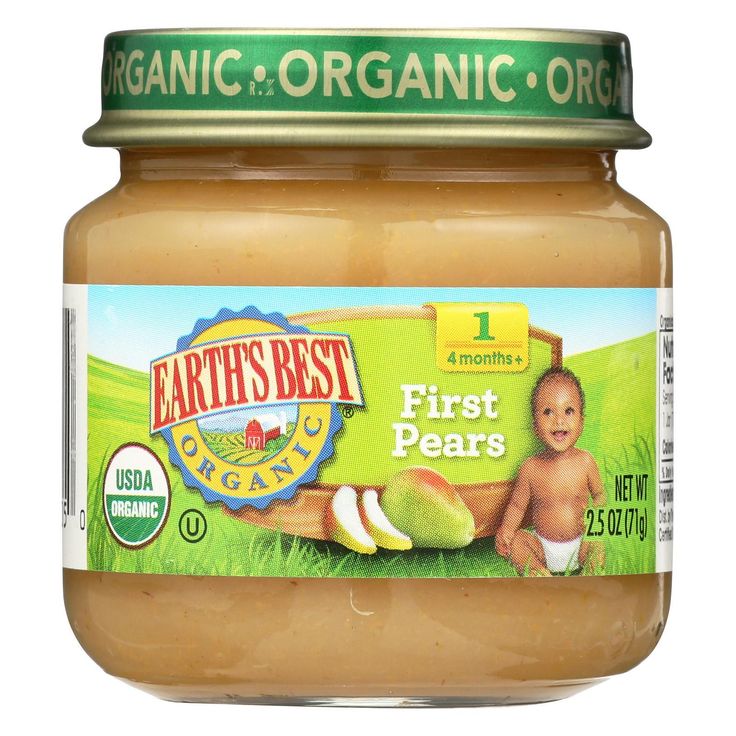
Infant formula has been developed and improved over the years to end up like breast milk. We will find out what kind of infant formula is available and how to choose an infant formula. nine0007
The national program provides for the possibility of mixed and artificial feeding with adapted milk mixtures. They are made from animal milk, which is modified in such a way that the components of the mixture, as a result, repeat the composition and properties of breast milk and correspond to the physiological needs of children in infancy and early childhood[1].
Types of infant milk formulas:
- standard or basic;
- treatment and prophylactic;
- medical.
Which infant formula is best? The answer depends primarily on the state of health of a particular child. It is important to remember that some children are not suitable for regular formulas, they need to eat formulas of specialized formulas: they are introduced to eliminate the symptoms of lactose intolerance, treat allergies to cow's milk proteins, reduce or stop spitting up, get rid of constipation and other problems.
All mixtures are given as prescribed by a physician. Despite this, parents should themselves understand the composition and features of artificial nutrition in order to clearly know which set of components the baby needs and better understand the recommendations of a specialist. nine0007
This is important
The first rule when choosing infant formula is to work with your pediatrician to find out what your baby needs and find out if the formula is right for him. The best infant formula is the one on which the baby gains weight normally and also feels good during and after feeding.
Types of infant formulas by age
Mixtures are selected not only by purpose, but also by age. According to the numbers indicated on the jars (packs), which are called steps, you can determine the stage of feeding:
- 1st stage (initial, or starting mixtures) - from 0 to 6 months;
- 2nd stage (subsequent mixtures) - from six months to 12 months;
- Stage 3 (milk drinks) - from one to three years.
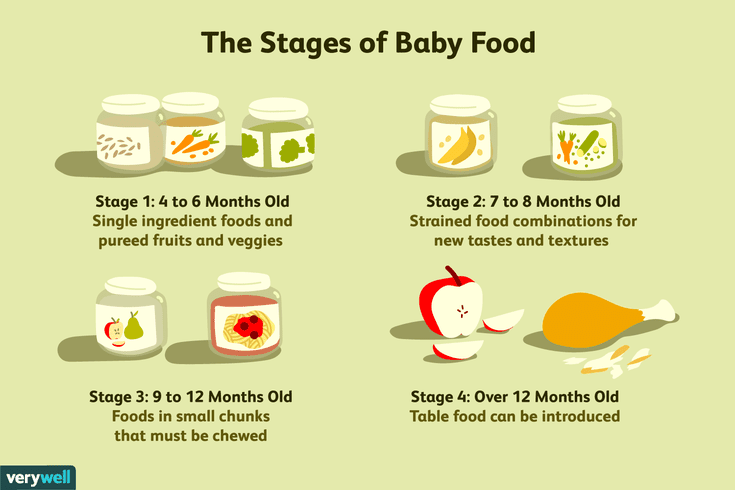
Note that this is not the only possible classification. For example, among milk formulas there are universal "from 0 to 12 months", designed to feed a child throughout the first year of his life, and mixtures labeled "PRE" for premature babies. nine0007
Age-appropriate formulas are formulated to meet the nutritional needs of newborns, infants and toddlers and their ability to digest and absorb food. Mixtures vary greatly in the amount of proteins, fats, carbohydrates and minerals. And the transition to the mixture of the next step should be timely, because a lack of nutrients or, conversely, an “overload” with them can lead to health problems for the baby.
Important
The second rule in choosing a formula is to focus on a specific age group: formula 2 formula 2 must not be given before six months or one and a half years, formula cannot be replaced with regular milk. After a year, you should also not rush to introduce whole milk: it has few vitamins, minerals, but a lot of protein and fat, and this can cause digestive disorders.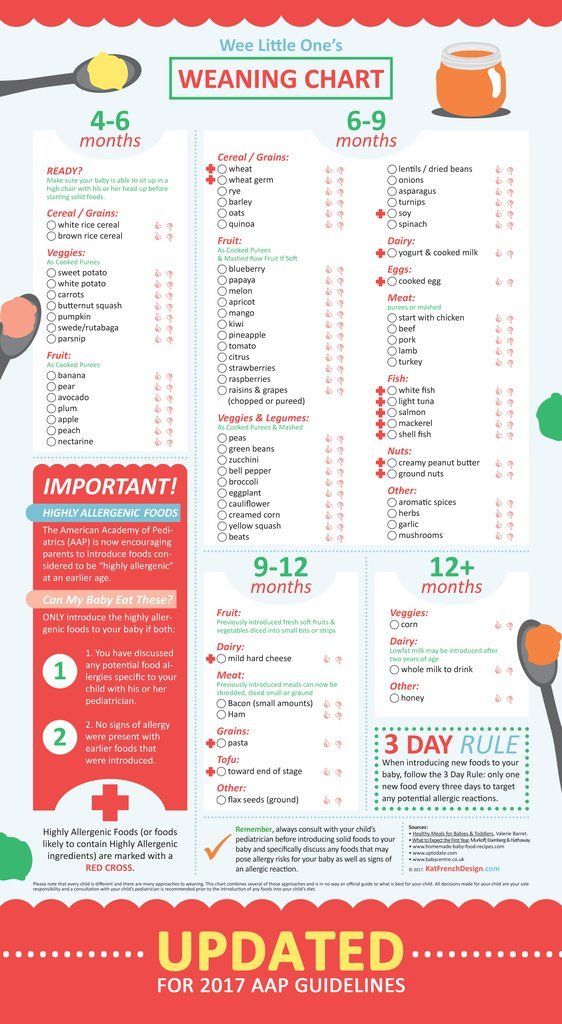 From formula 3 formula, a one-year-old baby will receive a significant portion of the daily requirement of nutrients in a form suitable for his small tummy. nine0005
From formula 3 formula, a one-year-old baby will receive a significant portion of the daily requirement of nutrients in a form suitable for his small tummy. nine0005
Types of infant formula by form
There are two types: liquid and dry. Ready-made infant formulas in liquid form are not widely used in Russia. Powdered infant formula is the most popular. Not only are they economical, their free-flowing texture allows you to measure the exact amount of powder your child needs according to their age. This is a convenient option for both supplementary feeding and full artificial feeding. You just need to follow the recommendations of the doctor regarding the volume of servings, and the manufacturer's instructions for diluting the mixture in water. If you add powder in excess of the norm or, conversely, less, this will lead to a change in the concentration of nutrients, which can even be harmful to the health of the baby. nine0007
What is contained in infant formula and how they differ in composition
As a rule, infant formula contains four groups of components: protein, carbohydrate, fat, vitamin and mineral.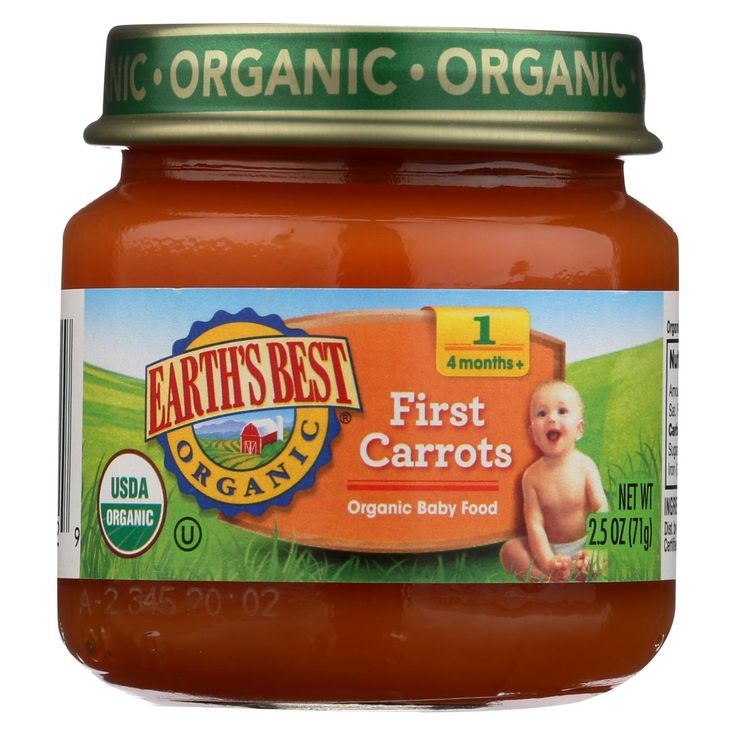 What then distinguishes one product from another? They differ in the degree of similarity of the composition with breast milk and in the number of basic and the presence of additional functional components that have a beneficial effect on child development.
What then distinguishes one product from another? They differ in the degree of similarity of the composition with breast milk and in the number of basic and the presence of additional functional components that have a beneficial effect on child development.
Proteins. Mature breast milk contains about 60% whey protein and 40% casein [2] . In many initial formulas, similar proportions - so the protein is easier to digest. Whey protein in the stomach forms a soft clot that resembles cottage cheese in texture. It is faster and easier to ferment and digest than casein, which takes much longer to digest. In subsequent mixtures, the ratio of proteins of the whey fraction to the casein fraction of 50:50 will be optimal.
Note
For better digestion of milk protein, demineralized whey is added to some mixtures. This increases the amount of whey protein and the quality of the protein component. And at the same time, thanks to this, the growth of all body tissues, good weight and healthy kidneys of the baby are ensured. nine0005
nine0005
Fats serve as an energy reserve for the whole organism. Breast milk fats consist of saturated and unsaturated fatty acids, including linoleic and α-linolenic acids - they should be a mandatory component of dry infant formula. Docosahexaenoic acid (DHA) and arachidonic acid (ARA), which are found in breast milk, are used to further fortify formulas. They are important for the development of mental and visual functions.
To form the fat component of the mixture, vegetable oils are mainly used: sunflower, palm, coconut, soybean, corn and other raw materials. nine0007
This is interesting
There is a tendency in modern baby food production to use milk lipids instead of palm oil in formulas as a source of useful essential fatty acids, including the “correct” palmitic acid. Such a fatty composition makes the stool softer in artificial children.
Carbohydrates. Most formulas contain lactose (milk sugar, the main source of carbohydrates in breast milk) as the carbohydrate component, which aids in the absorption of macronutrients.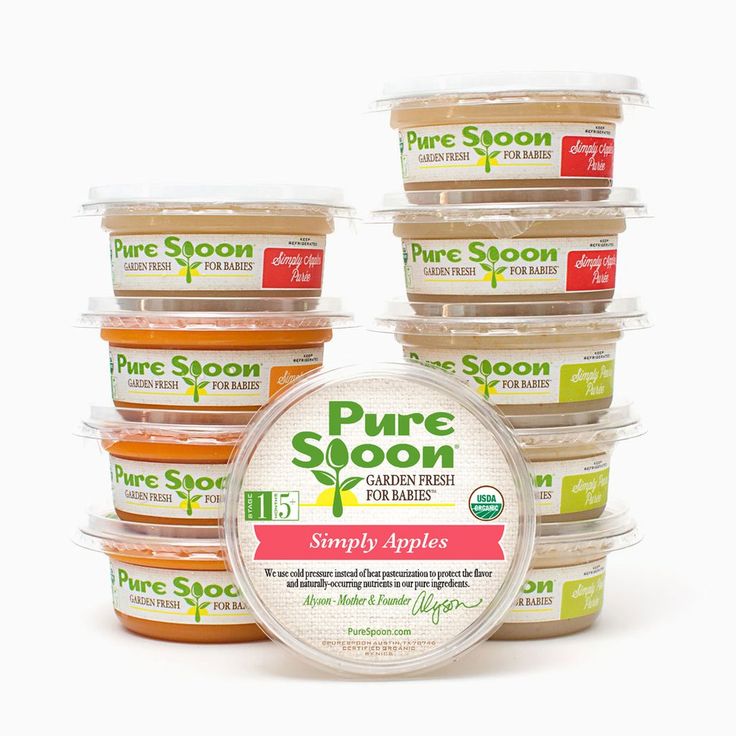 There is also a combination of lactose and maltodextrin (it contains a smaller proportion), due to which the baby gets a longer feeling of fullness after consuming the mixture. Also important is the presence in mixtures of prebiotic oligosaccharides (POS) characteristic of mother's milk: together with bifidobacteria, they help resist the growth of harmful bacteria and stimulate the intestines and immune system of a formula-fed baby. nine0007
There is also a combination of lactose and maltodextrin (it contains a smaller proportion), due to which the baby gets a longer feeling of fullness after consuming the mixture. Also important is the presence in mixtures of prebiotic oligosaccharides (POS) characteristic of mother's milk: together with bifidobacteria, they help resist the growth of harmful bacteria and stimulate the intestines and immune system of a formula-fed baby. nine0007
Vitamins and minerals are contained in a certain concentration and ratio. However, due to the reduced digestibility of vitamins from the mixture, they are added to the formula in larger quantities when compared with mother's milk [3].
In infancy and early life, it is especially important that children receive adequate amounts of vitamin D (prevention of rickets), iron (reduces anemia), calcium (strengthens bones and teeth), iodine (involved in intellectual development) and B vitamins (immunity support factor and protection against neurological disorders, sleep disorders, tremors). nine0007
nine0007
Permissible levels of all nutrients in infant formula are regulated by the Technical Regulations of the Customs Union "On the Safety of Milk and Dairy Products" (TR CU 033/2013)[4].
This is important
The third rule in choosing a mixture is to thoroughly study the composition. In addition to essential nutrients, some formulas are fortified with functional ingredients that enhance their quality and benefits, including improving digestion and immunity, developing cognitive functions and developing vision in newborns and infants. nine0005
Cow vs goat milk
When it comes to formula base, cow milk is more commonly used than goat milk. Despite the apparent simplicity of choosing the type of milk, its good tolerance is of great importance. This means clear skin without rashes and redness, no colic, no profuse regurgitation and mucus in the stool, as well as excellent appetite and weight gain in the child.
Information
Some children have a poor digestive system for milk protein, but they still tolerate goat's milk well. If there is evidence of individual intolerance to cow's milk proteins in the family history, then the child can be recommended a goat mixture. However, the identified childhood allergy to cow's milk proteins requires diet therapy using specialized mixtures based on hydrolysis or amino acids. nine0005
If there is evidence of individual intolerance to cow's milk proteins in the family history, then the child can be recommended a goat mixture. However, the identified childhood allergy to cow's milk proteins requires diet therapy using specialized mixtures based on hydrolysis or amino acids. nine0005
Fatty components also facilitate the process of digestion due to their size: in goat's milk they reach 0.1-2 microns, and in cow's - 2-4 microns. The carbohydrate composition in animal milk is similar and includes lactose and oligosaccharides. But there are ten times more of the latter in goat's milk, which contributes to the active growth of beneficial microflora.
In addition, the production of both women's and goat's milk is characterized by the same type of secretion - apocrine, in which cellular protective components, such as nucleotides, free amino acids, lysozymes, enter the child's body with nutrition. nine0007
All the listed properties of goat's milk are "transferred" to mixtures based on it, the benefits of which are constantly evaluated.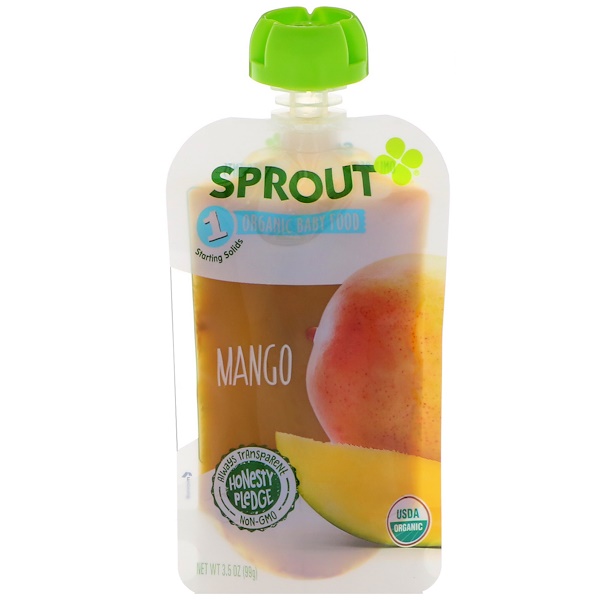 So, in the course of one of the studies, it was found that children who were fed mixtures with goat's milk grew better and gained weight [5].
So, in the course of one of the studies, it was found that children who were fed mixtures with goat's milk grew better and gained weight [5].
Nestle Nan Optipro 1 | Powdered infant formula
0-6 months
Product NAN® 3, 4
nine0161 5/5 42 reviews
Important to know
During the first 6 months of life, nutrition is essential for your baby's healthy development. During this period, it is necessary to give the child appropriate nutrition, including the right amount and quality of protein, which will help lay a solid foundation for his health today and in the future.
NAN® 1 OPTIPRO® formula is intended for feeding healthy babies from birth when breastfeeding is not possible. nine0007
Composition
Ingredients: skimmed milk, demineralised whey, maltodextrin, vegetable oils (low erucic acid rapeseed, sunflower, high oleic acid sunflower, coconut), milk fat, lactose, calcium citrate, 'FL, fish oil, phosphate potassium, vitamins (C, E, pantothenic acid, niacin, thiamine (vitamin B1), A, B6, riboflavin (vitamin B2), folic acid, K, biotin, D, B12), acidity regulator potassium hydroxide, iron sulfate, sulfate zinc, culture of bifidobacteria Bifidobacterium lactis (bifidobacterium lactis) (not less than 1x10[6] CFU (CFU)/g(g)), copper sulfate, potassium iodide, selenium. Packed in a protective environment. nine0007
Packed in a protective environment. nine0007
Nutritional information
| Units | Per 100 g dry powder | For 100 ml ready-to-drink milk | |
|---|---|---|---|
| Energy value | kJ (kJ)/kcal (kcal) | 2173/ 519 | 281/67 |
| Zhiri | g/g | 27 | 3.58 |
| of which saturated | g/g | 8 | 1.1 |
| Linoleic acid | g/g | 4 | 0.58 | nine0190
| α-Linolenic acid | g/g | 0 | 0. 06 06 |
| Arachidonic acid (ARA) | mg/mg | 61 | 7.87 |
| Docosahexaenoic acid | mg/mg | 61 | 7.87 |
| Carbohydrates | g/g | 57 | 7.45 |
| of which sugars | g/g | 57 | 7.45 |
| Lactose | g/g | nine0194 577.45 | |
| Oligosaccharides (2'-fucosyllactose) | g/g | 0 | 0. 03 03 |
| Proteins | g/g | 9 | 1.24 |
| Whey proteins / casein | % | 70/30 | 70/30 |
| Minerals (ash) | g/g | 2 | 0.36 |
| Sodium | mg/mg | 130 | 16.78 | nine0190
| Potassium | mg/mg | 650 | 83.91 |
| Chlorides | mg/mg | 350 | 45. 18 18 |
| Calcium | mg/mg | 330 | 42.6 |
| Phosphorus | mg/mg | 195 | 25.17 |
| Magnesium | mg/mg | 44 | 5.68 |
| Manganese | µg/µg | 100 | nine0194 12.91|
| Selenium | µg/µg | 13 | 1.68 |
| Vitamin A | µg/µg | 530 | 68. 42 42 |
| Vitamin D | µg/µg | 7.5 | 0.97 |
| Vitamin E | mg/mg | 9 | 1.16 |
| Vitamin K | µg/µg | 50 | 6.45 |
| Vitamin C | mg/mg | 75 | 9.68 |
| Vitamin B1 | mg/mg | 0.58 | 0.07 |
| Vitamin B2 | mg/mg | 1.1 | 0. 14 14 |
| Niacin PP | nine0194 mg/mg4.5 | 0.58 | |
| Vitamin B6 | mg/mg | 0.38 | 0.05 |
| Folic acid | µg/µg | 75 | 9.68 |
| Pantothenic acid | mg/mg | 5 | 0.065 |
| Vitamin B12 | µg/µg | 1.4 | 0.18 |
| Biotin | µg/µg | 13 | 1. 68 68 |
| Choline | mg/mg | 95 | 12.26 |
| Inositol | mg/mg | 75 | 9.68 |
| Iron | µg/µg | 4.9 | nine0194 0.63|
| Iodine | µg/µg | 110 | 14.2 |
| Copper | µg/µg | 0.4 | 0.05 |
| Zinc | mg/mg | 5.4 | nine0194 0.7|
| Taurine | mg/mg | 36 | 4. 65 65 |
| L-carnitine | mg/mg | 8 | 1.03 |
| Nucleotides | mg/mg | 15.6 | 2.01 |
| Resinability | kg | 320 | |
| Bifidobacterium culture B. lactis | CFU/g (CFU/g) | not less than 1.0x10 |
Preparation method nine0007
1.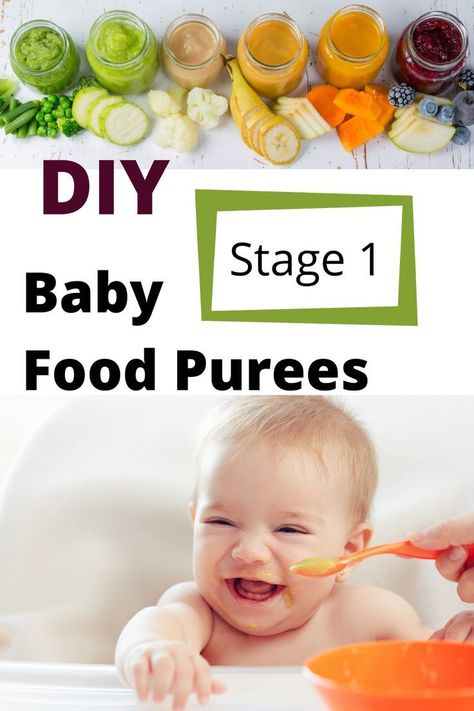 Wash your hands before preparing formula.
Wash your hands before preparing formula.
2. Wash the bottle, teat and cap thoroughly. Boil them for 5 minutes. Cover before use.
3. Boil drinking water and then cool to 37°C.
4. Referring to the feeding chart, pour exactly measured amount of warm water into the boiled bottle. Then add the exact number of scoops of powder according to your child's age. For preparation, use only a measuring spoon filled without a slide. nine0007
5. Make sure the spoon is dry and put it back in the jar. After preparing the mixture, the jar of powder should be tightly closed and stored in a cool, dry place.
6. Close the bottle and shake well until the powder is completely dissolved. Check temperature before feeding.
WARNING
Mix should be prepared immediately before feeding. Follow the cooking instructions exactly. The diluted mixture remaining after feeding is not subject to storage and subsequent use. During feeding, it is necessary to support the child so that he does not choke. nine0007
The diluted mixture remaining after feeding is not subject to storage and subsequent use. During feeding, it is necessary to support the child so that he does not choke. nine0007
WARNING
The use of unboiled water and unboiled bottles, as well as improper storage, transport, preparation and feeding can lead to adverse effects on the health of the child.
IMPORTANT NOTE
Breastfeeding is preferred for feeding young children. The ideal food for an infant is mother's milk. Breastfeeding should continue as long as possible. Before deciding to bottle feed with infant formula, seek the advice of a healthcare professional. nine0007
The amount of formula recommended in the table and the frequency of feeding may vary depending on the individual child. Please consult a specialist.
*To maintain the number of live bacteria, boiled water should be cooled to about body temperature (37 °C) and then dry powder should be added.
**Note: Use the enclosed measuring spoon filled without a heap to mix. Dilution of the wrong amount of powder - more or less than the amount indicated in the table - can lead to dehydration of the child's body or malnutrition. nine0007
The indicated proportions must not be changed without the advice of a healthcare professional.
***Consult your healthcare professional before introducing any new foods to your child's diet. If your doctor has advised you to introduce new foods earlier, reduce your formula intake as recommended. A child's needs may vary by age. Note: Avoid prolonged storage at high temperatures.
Shelf life and storage conditions nine0007
Before and after opening, store the product at a temperature not exceeding 25 ℃ and relative humidity not more than 75%. After preparing the mixture, the packaging with the product should be tightly closed. After opening, use within 3 weeks, it is not recommended to store in the refrigerator.
Other flavors and formats
From birth
0-6 months
Product nine0007
Dry infant formula "NAN® 1 OPTIPRO®" with oligosaccharide 2'FL for children from birth
Learn more
0-6 months
Product
Dry infant formula "NAN® 1 OPTIPRO®" with oligosaccharide 2'FL for children from birth
Learn more
0-6 months
Product
Dry infant formula "NAN® 1 OPTIPRO®" with oligosaccharide 2'FL for children from birth nine0079
Learn more
From 6 months
6-12 months
Product
Dry milk formula for after-feeding "NAN® 2 OPTIPRO®" with oligosaccharide 2'FL for children from 6 months
Learn more
6-12 months
Product
Dry milk formula for after-feeding "NAN® 2 OPTIPRO®" with oligosaccharide 2'FL for children from 6 months nine0079
Learn more
FROM 12 MONTHS
12-18 months
Product
Powdered milk formula "NAN® 3 OPTIPRO®" with oligosaccharide 2'FL for children from 12 months
Learn more
12-18 months
Product
Powdered milk formula "NAN® 3 OPTIPRO®" with oligosaccharide 2'FL for children from 12 months nine0079
Learn more
FROM 18 MONTHS
18-24 months
Product
Powdered milk formula "NAN® 4 OPTIPRO®" with oligosaccharide 2'FL for children from 18 months
Learn More
Latest Reviews
Average Customer Rating
42 customer ratings
Snapshot of community ratings
- five 41
- 4 0
- 3 one
- 2 0
- one 0
Recommended products
6-12 months
Product
Dry milk formula for after-feeding "NAN® 2 OPTIPRO®" with oligosaccharide 2'FL for children from 6 months nine0079
Learn more
12-18 months
Product
NAN® Blend Hypoallergenic 3 OPTIPRO® HA (HypoAllergenic) from 12 months
NAN® Hypoallergenic 3 OPTIPRO® HA is a specially formulated infant milk for children over 12 months of age to replace cow's milk in a child's diet.











